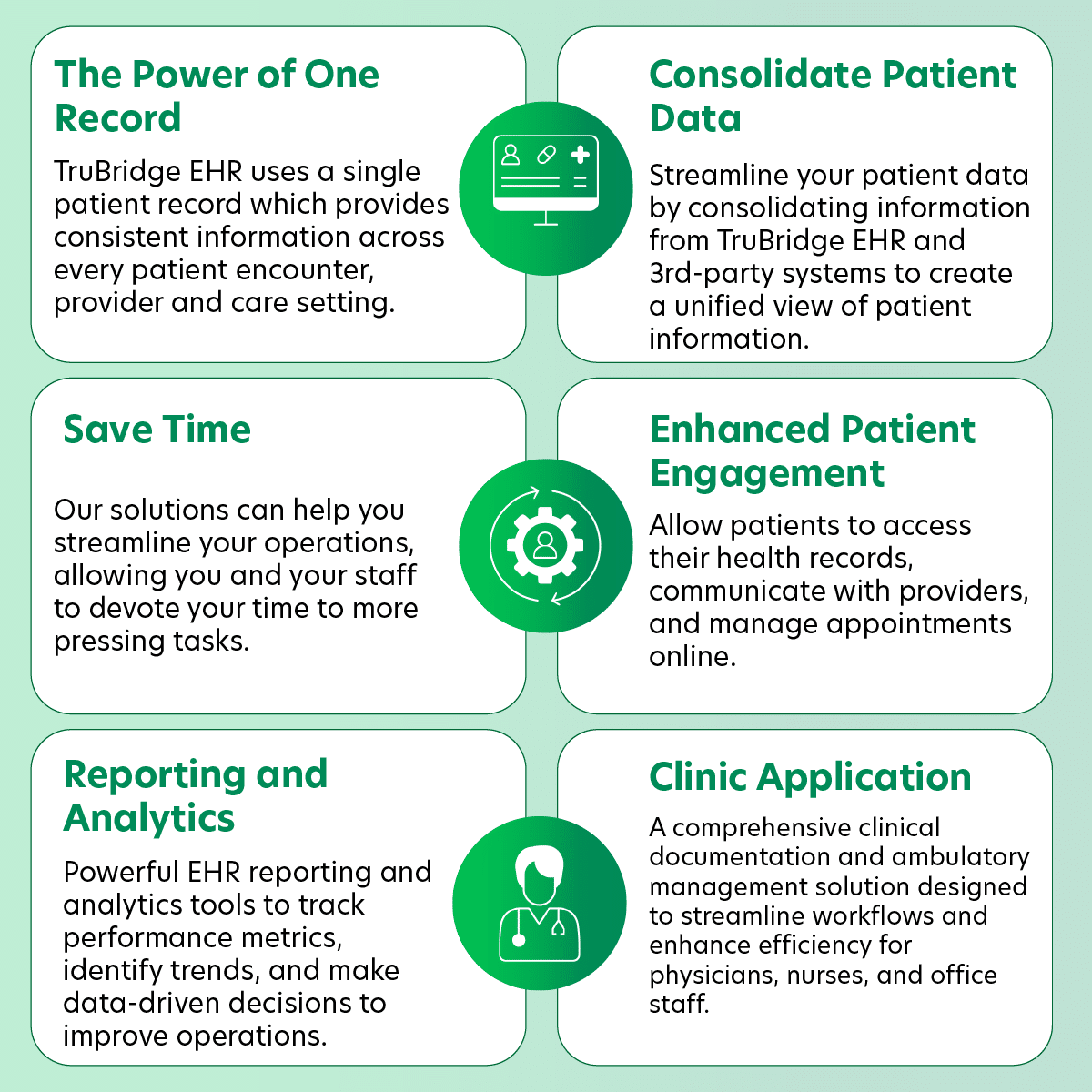Electronic Health Record and Health Information Systems
Electronic Health Record Solutions for Long-Term Success
EHR and EMR Solutions for Healthcare Providers
Streamline operations with TruBridge EHR software & services
Our EHR software integrates seamlessly with existing healthcare systems, offering a comprehensive EHR solution for clinics, hospitals, and therapists. With features such as electronic health record integration, patient records software, and electronic medical records integrations, TruBridge simplifies the management of medical charts and ensures a smoother, more efficient patient care process.
TruBridge EHR supports:
-
Physicians
-
Clinical Staff
-
Patient Management
-
Enterprise Modules
-
Health Information Management
-
Financial Management
-
Clinical Applications
-
Patient Engagement


Why TruBridge? Real Results, Real Impact.
Our EHR system is more than just software, it’s a comprehensive, fully integrated solutions tailored to meet the needs of rural and community hospitals. Designed to improved patient care, streamline clinical workflows, and optimize financial performance, our system support hospitals and enhancing operational efficiency and delivering better outcomes.

Maximize Surgical Efficiency
66% lower OR turnover time

Streamline Documentation
80% reduction in charting time

Speed Up Patient Processing
40% reduction in triage time
Explore All TruBridge EHR Application
-
- ChartLink® – EHR Portal
- Computerized Physician Order
- Entry
- Physician Documentation – Notes
- Emergency Department
- Clinical Content
- Mobile Rounding
- TruBridge Provider EHR
- Clinical Documentation
- Practice Management
- ImageLink®-PACS
- Application Portal
-
- Multi-disciplinary
- Patient Documentation
- Care Plans
- Patient Acuity
- Clinical Content
- Patient Education
- Order Entry/Results Reporting
- Medication Management
- Medication Reconciliation
- Inpatient e-Prescribing
- Medication Administration Verification
- Resident Assessment Instruments
- Inpatient Rehabilitation Facility-Patient Assessment Instrument
- Core Measures System/CMS Reporting
-
- Laboratory Information System (LIS)
- Quality Control
- Microbiology
- Blood Administration
- Anatomic Pathology
- Radiology Information System
- Mammography Data
- Application
- Physical Therapy
- Cardiopulmonary
- Pharmacy
- Pharmacy Clinical Monitoring
- Drug Interactions
- Patient Drug Education
- Operating Room Management
- Laboratory Information System (LIS)
-
- Interoperability
- Auto-Fax
- Ad Hoc Report Writer
- ODBC Database Access
- Archival Data Repository
- HIS Server Automated Backup
- High Availability/Redundancy Offerings
- Interface Management System
- Virtual Server System
- Test Server
- Training System
-
- Home Health – Administration
- Home Health – Point of Care
- Enterprise Wide Scheduling
- Electronic Forms
-
- Executive Information System (EIS)
- General Ledger
- Budgeting
- Fixed Assets
- Accounts Payable
- Electronic Funds Transfer (EFT)
- Laser Checks with Secure Signature
- Time & Attendance
- Human Resources
- Payroll/Personnel
- Direct Deposit Interface
- Materials Management
- Electronic Purchase Order Submission


Comprehensive Provider EHR
TruBridge Provider EHR simplifies clinical workflows, streamlines documentation, and improved patient care.
-
Mobile Access & Mobile Rounding: Healthcare providers can easily update patient records from any location improving access to real-time patient data.
-
Efficient Physician Documentation & Order Entry: Reduce time spent on administrative tasks and improving clinical documentation efficiency and support accurate order entry.
-
Clinical Content Integration for Inpatient, Outpatient & Emergency Care: Comprehensive support for healthcare providers access inpatient, outpatient, and emergency settings, optimizing clinical decision-making and care coordination.

Healthcare Policy Updates
Healthcare regulations are changing rapidly, and staying informed is essential. Our Healthcare Policy Updates produces the latest insights, summaries, and resources to help you navigate evolving requirements with confidence. Explore now to insure your organization is prepared for what’s ahead.
Next-Level Patient Engagment
Engagement patient more effectively with tools that allow for real-time access to their health data, improving outcomes and satisfaction.
-
Interactive Health Data: Present health information in an easy-to-read format (graphs, chart, etc.)
-
Secure Messaging & Communication: Foster communication between patients and care teams outside of appointments.
-
Empowering Patients: Give patients a more active role in their healthcare through self-management tools.
-
Provider Documentation: Streamline and digitize provider documentation for improved efficiency and compliance.


Let's Talk.
Start Transforming Your EHR & Patient Engagement
Ready to take the next step? Schedule an EHR demo today and discover how TruBridge can transform your healthcare operations.
EHR Insights
FAQs
-
To correct an electronic health record, authorized staff must add an addendum or amendment that explains the error and provides the correct information. The original entry is never deleted or altered, maintaining a complete audit trail for legal and compliance purposes.
-
The long-range goal of electronic health records is to improve the quality, safety, and efficiency of healthcare by enabling seamless, secure access to patient information across providers. EHRs aim to support better clinical decision-making, enhance care coordination, reduce medical errors, and empower patients through greater access to their health data.
-
Yes, electronic health records (EHRs) are designed with multiple layers of security to protect patient information, including encryption, access controls, and audit trails. However, like any digital system, they can be vulnerable to cyber threats, so ongoing security updates, staff training, and strong data protection policies are essential to keep them safe.
-
Electronic health records (EHRs) improve workflow by streamlining documentation, automating routine tasks like prescribing and lab orders, reducing paperwork, and allowing instant access to patient information. This enhances communication among care teams, minimizes errors, and increases overall efficiency in healthcare delivery. Although initial costs can be high, in the long run these costs are offset by the efficiencies gained.
-
An electronic health record (EHR) system supports patient safety by providing real-time access to accurate patient information, reducing medication errors through electronic prescribing, alerting providers to potential drug interactions or allergies, and improving care coordination across healthcare teams.
-
Electronic health records reduce medical errors by improving accuracy in documentation, providing clinical decision support, alerting providers to drug interactions or allergies, and minimizing miscommunication through clear, real-time access to patient information across the care team. Also, having a good digital backup strategy further ensures less errors.
-
Implementing an EHR system involves several key steps:
- Planning & Needs Assessment – Identify goals, requirements, and budget.
- Vendor Selection – Choose an EHR system that fits your organization’s size and specialty.
- System Customization – Configure the system to match workflows and regulatory needs.
- Data Migration – Securely transfer existing patient records into the new system.
- Staff Training – Provide comprehensive training for all users.
- Go-Live & Support – Launch the system with technical support in place to handle issues.
- Ongoing Evaluation – Monitor performance and make adjustments to improve efficiency and usability.
A thoughtful, phased approach helps ensure a smooth transition and long-term success.
-
The effectiveness of electronic health records can be measured through key performance indicators such as improved patient outcomes, reduced medical errors, faster documentation, increased provider productivity, enhanced care coordination, and patient satisfaction. Metrics like claim denial rates, chart completion times, and user adoption rates also help assess EHR performance.




